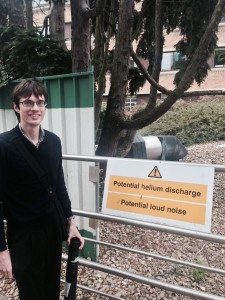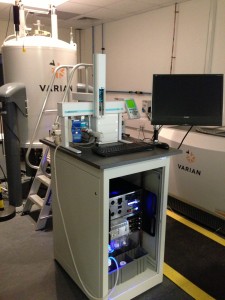Matt (pictured above left at the top of the 950 MHz magnet in Oxford) is a PhD student working on a joint BBSRC/UCB Biopharma funded project entitled “The investigation of the scope and limitations of capillary flow NMR as a medium throughput screening technology for generation of positional information in ligand-protein and protein-protein complexes”.
This project is the continuation of a highly successful collaboration that has demonstrated the application of mass spectrometry as a fast method for screening ligands which are weakly and non covalently bound to proteins of therapeutic interest with considerable potential in high throughput screening within the pharmaceutical industry.
Matt’s project is building on this foundation by exploring the application of capillary flow NMR technology as a primary fragment screening tool. NMR spectroscopy can provide atomic resolution binding location information avoiding the need for crystallization and is exquisitely sensitive to the small changes in magnetic environment making it ideally suited for studying very weak interactions. Recently capillary flow NMR technology has become available at Bristol and this has the potential to significantly reduce both the amounts of isotopically labelled protein required per ligand screen and/or the NMR experimental acquisition time. The project will explore the application of capillary flow NMR hardware and in-line automated fluidics to protein and ligand detect NMR experiments that are typically applied in fragment screening. The picture above right shows the pump system supplied by Protasis and LEAP liquid handler for 50 micro-litre injections into the 6.5mm salt tolerant triple resonance cryo-probe on a VNMRS 600 MHz Spectrometer. Integration and operation is a breeze with Agilent’s vnmrJ 4.0 and the programming input from Frank Delaglio! The results will be cross-validated using a cryoprobe equipped 600 MHz instrument (both at UCB and Bristol) and there will be scope to extend protein-ligand interaction studies to full solution structure determinations.
In tandem the project will develop new methods for measuring protein-protein interactions in pharmaceutically relevant targets using biological mass spectrometry in conjunction with H/D exchange. Mass spectrometry will be performed at UCB using a state of the art WATERS 2nd generation SYNAPT high resolution mass spectrometer. The combination of the two techniques will provide critical structural information on the binding of small molecule fragments to target proteins.

